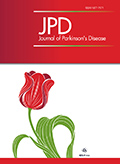Authors: Béreau, Matthieu | Castrioto, Anna | Lhommée, Eugénie | Maillet, Audrey | Gérazime, Aurélie | Bichon, Amélie | Pélissier, Pierre | Schmitt, Emmanuelle | Klinger, Hélène | Longato, Nadine | Fraix, Valérie | Benatru, Isabelle | Durif, Franck | Azulay, Jean-Philippe | Moro, Elena | Broussolle, Emmanuel | Tranchant, Christine | Anheim, Mathieu | Thobois, Stéphane | Krack, Paul
Article Type:
Research Article
Abstract:
Background: Fatigue is a frequent and troublesome symptom present from the early stages of Parkinson’s disease (PD). Objective: To examine the relationship between fatigue and the neuropsychiatric triad, which includes apathy, depression, and anxiety, in de novo PD. Methods: We performed a cross-sectional study including 197 patients with de novo PD and assessed fatigue using the Parkinson’s Disease Fatigue Scale (PDFS-16). We evaluated motor status using the Unified Parkinson’s Disease Rating Scale (UPDRS) part III score and evaluated neuropsychiatric status using the Ardouin Scale of Behavior in Parkinson’s Disease (ASBPD). We carried out univariate
…and multivariate analyses to model association between motor signs, non-motor signs, and fatigue risk. Results: Frequency of fatigue (28.9%) was of the same order of magnitude as that of apathy. PD patients with fatigue reported a lower quality of life than patients without fatigue (p < 0.0001). The ASBPD showed that patients with fatigue had higher scores for depressed mood (p < 0.0001), anxiety (p < 0.0001), and apathy (p < 0.0001). In the univariate analysis, fatigue score was positively correlated with apathy, depression, anxiety, and the neuropsychiatric triad as a whole, and to a lesser extent with female sex, hyperemotivity, and the UPDRS part III score. In the multivariate analysis, after adjusting for sex and motor status, the fatigue score remained significantly correlated with apathy (OR = 11.17 [4.33–28.78], p < 0.0001) and depression (OR = 4.28 [1.39–13.12], p = 0.01), but not with anxiety (OR = 0.94 [0.34–2.58], p = 0.9). Conclusion: We propose that the neuropsychiatric triad could be expanded to include fatigue.
Show more
Keywords: Parkinson’s disease, fatigue, apathy, depression, motivation
DOI: 10.3233/JPD-213116
Citation: Journal of Parkinson's Disease,
vol. 12, no. 4, pp. 1329-1337, 2022
Price: EUR 27.50






